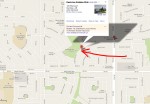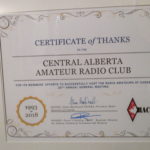- Home
- Registration
- Site Tools
- Articles
- Swap n Shop
- Contesting
- Grounding information for everyone
- History of the Central Alberta Amateur Radio Club
- CAARC owned Repeaters
- Club Repeater Info
- GMT Time Conversion Table
- VE/VA6 Incoming QSL Bureau
- Pine Lake Tornado Friday July 14, 2000.
- Amateur Radio to the Rescue
- CANWARN
- HAM Nation with Bob Heil K9EID
- Net info
- Events.
- ARES
- Links and On line study course.
- Field Day 2019
- Members D/L
- Forum/Swap and Shop

Astronaut Owen Garriott, W5LFL, SK
Apr 16th
Amateur Radio in Space Pioneer Astronaut Owen Garriott, W5LFL, SK

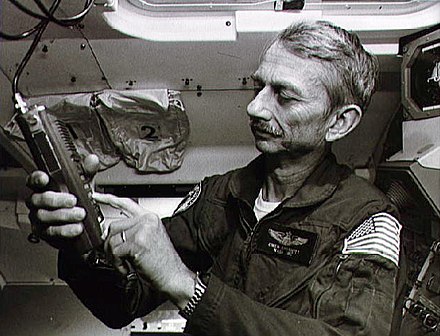
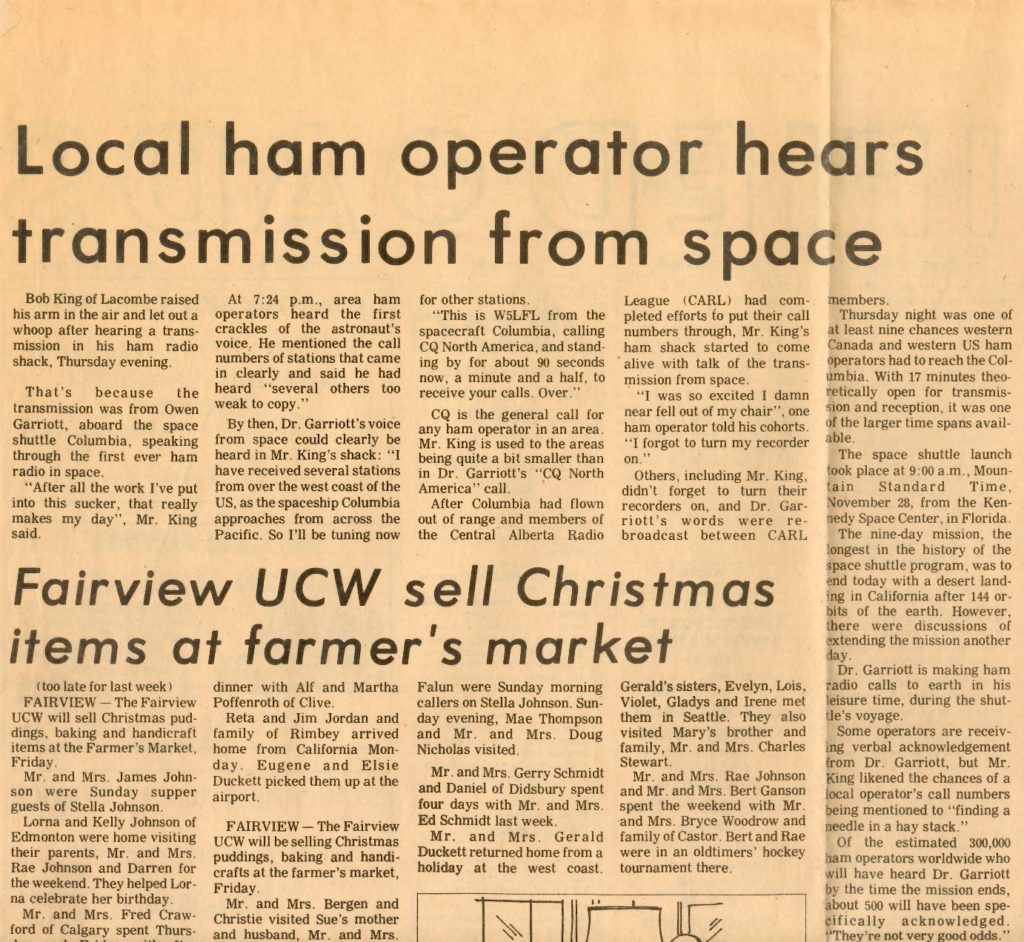
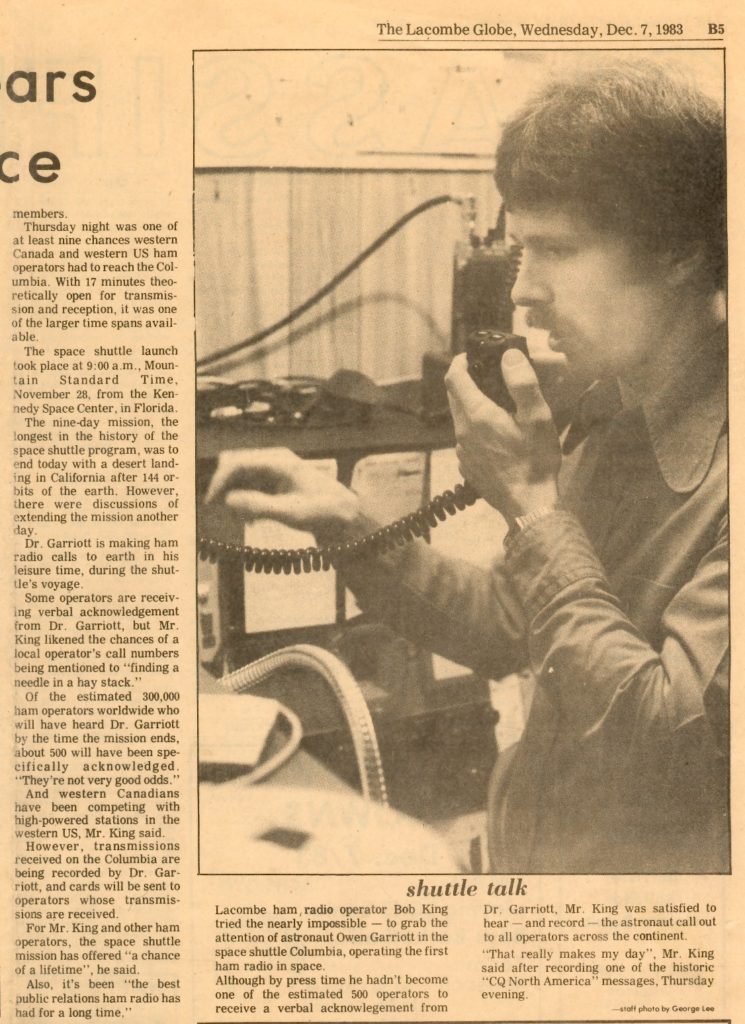
04/15/2019
The US astronaut who pioneered the use of Amateur Radio to make contacts from space — Owen K. Garriott, W5LFL — died April 15 at his home in Huntsville, Alabama. He was 88. Garriott’s ham radio activity ushered in the formal establishment of Amateur Radio in space, first as SAREX — the Shuttle Amateur Radio Experiment, and later as ARISS — Amateur Radio on the International Space Station.
“Owen Garriott was a good friend and an incredible astronaut,†fellow astronaut Buzz Aldrin tweeted. “I have a great sadness as I learn of his passing today. Godspeed Owen.â€
An Oklahoma native, Garriott — an electrical engineer — spent 2 months aboard the Skylab space station in 1973 and 10 days aboard Spacelab-1 during a 1983 Space Shuttle Columbia mission. It was during the latter mission that Garriott thrilled radio amateurs around the world by making the first contacts from space. Thousands of hams listened on 2-meter FM, hoping to hear him or to make a contact. Garriott ended up working stations around the globe, among them such notables as the late King Hussein, JY1, of Jordan, and the late US Senator Barry Goldwater, K7UGA. He also made the first CW contact from space. Garriott called hamming from space “a pleasant pastime.â€
“I managed to do it in my off-duty hours, and it was a pleasure to get involved in it and to talk with people who are as interested in space as the 100,000 hams on the ground seemed to be,†he said in an interview published in the February 1984 edition of QST. “So, it was just a pleasant experience, the hamming in particular, all the way around.â€
Although Garriott had planned to operate on ham radio during his 10 days in space, no special provisions were made on board the spacecraft in terms of equipment — unlike the situation today on the International Space Station. Garriott simply used a hand-held transceiver with its antenna in the window of Spacelab-1. His first pass was down the US West Coast.
“[A]s I approached the US, I began to hear stations that were trying to reach me,†he told QST. “On my very first CQ, there were plenty of stations responding.†His first contact was with Lance Collister, WA1JXN, in Montana.
ARISS ARRL Representative Rosalie White, K1STO, met Garriott when he attended Hamvention, “both times, sitting next to him at Hamvention dinner banquets,†she recounted. “Once when he was a Special Achievement Award winner, and once with him and [his son] Richard when Richard won the 2009 Special Achievement Award. Owen was unassuming, very smart, kind, and up to date on the latest technology.†Garriott shared a Hamvention Special Achievement Award in 2002 with fellow Amateur Radio astronaut Tony England, W0ORE.
Richard Garriott, W5KWQ, was a private space traveler to the ISS, flown there by the Russian Federal Space Agency, and he also carried ham radio into space.
New Amateur Radio Packet Gear Awaits Unpacking, Installation on Space Station
Dec 10th
New Amateur Radio Packet Gear Awaits Unpacking, Installation on Space Station
12/18/2018New Amateur Radio on the International Space Station (ARISS) packet equipment awaits unpacking and installation on board the station after arriving in November as part of the cargo transported via a Russian 71P Progress resupply vehicle. The new packet module for NA1SS will replace the current packet gear, which has been intermittent over the past year.
“With the arrival of Progress complete, the crew has to find free time unpack Progress, uninstall the intermittent module, and then set up and test the replacement packet module,†explained Dan Barstow, KA1ARD, senior education manager of the ISS National Laboratory (CASIS), an ARISS sponsor.
The ISS packet system was reported to have gone down in July 2017, although it unexpectedly came back to life the following summer. At the time of the failure, NASA ISS Ham Radio Project Engineer Kenneth Ransom, N5VHO, said the revived system would fill the gap until the replacement packet module was launched and installed. The packet system operates on 145.825 MHz. ARISS hardware team members on the ground were able to locate a functional duplicate of the ISS packet module that has been in use on the ISS for 17 years. ARISS said the subsequent installation will depend on the crew’s busy schedule.
In an email to ARISS and other groups CASIS supports, Barstow pointed out that ARISS is an official back-up system for astronauts to talk with Mission Control in the unlikely failure of the station’s primary communication systems.
Bartow said that in 2017, hams relayed nearly 89,000 packet messages via the ISS — an average of 243 every day. The statistic so intrigued and amazed Barstow that he decided to get his Amateur Radio license and gear to join in the activity.
Satellite stalwart and ARISS supporter Patrick Stoddard, WD9EWK, won the December 2018 QST Cover Plaque Award for his article, “Making Digital Contacts through the ISS.â€
Current International Space Station (ISS) crew members Serena Auñón-Chancellor, KG5TMT, Alexander Gerst, KF5ONO, and cosmonaut Sergey Prokopyev are scheduled to return to Earth on December 20 on a Soyuz vehicle.
SSO-A mission with Amateur Radio satellites launched December 3
Dec 5th
From AMSAT.UK

Spaceflight’s SSO-A SmallSat Express mission, carrying many amateur radio satellites, launched on a SpaceX Falcon 9 from Vandenberg Air Force Base at 18:34 GMT on Monday, December 3.
Watch the launch at https://www.youtube.com/watch?v=Wq8kS6UoOrQ
64 small satellites from 17 countries were launched on this mission, some with amateur radio payloads. A full list of satellites, can be found at
https://directory.eoportal.org/web/eoportal/satellite-missions/content/-/article/sso-a
Four microsatellites including ESEO, carrying an AMSAT-UK FUNcube-4 transponder, were deployed about 2 hours and 13 minutes after launch.
60 CubeSats including Jordan’s JY1SAT carrying a FUNcube-6 transponder and capable of transmitting Slow Scan Digital Video (SSDV) images deployed about 2 hours later.
EMO worker tries to drum up enthusiasm for ham radio
Oct 14th
EMO worker tries to drum up enthusiasm for ham radio
In an emergency, ham radio is an essential form of communication, Mike Johnson says

A free workshop about ham radios will be held in Sackville on Oct. 22. (Nicole Williams/CBC)
A ham radio probably isn’t the first form of communication a person thinks about in an emergency, but sometimes, it’s the only one that works.
Ham radios can use wireless transmission to send messages to battery-operated radios.
And they can be useful when large storms knock out telecommunications, says Mike Johnson, the Cumberland Regional Emergency Management co-ordinator.
He is partnering up with EOS Eco-Energy and the West Cumb Amateur Radio Club to hold a free workshop in Sackville to try get more people interested in ham radios.
Different technology
Johnson, who is also a member of the WestCumb club in Amherst, N.S., said that when we lose essential communications such as cellphones, landlines and the Internet — a ham radio can come to the rescue. Hurricane Michael, which struck Florida this week, devastated normal channels of communications.
Storms that knock out telecommunications for long periods of time create more problems for co-ordinated emergency response, he said.
He said he’s already seen how ham radios could help in New Brunswick.
In January 2017, a massive ice storm knocked out power to thousands in the northeast for days.
Operators dwindling
“It became very difficult,” said Johnson.
Today, ham radios are considered a hobby more than a necessity, and not many people know how they work.
“Our numbers are dwindling,” Johnson said of the amateur radio clubs.
But younger members are needed, especially since the clubs’ services may be needed even more as the climate changes.
“We still use Morse code to this day,” he said.
Requires a test
Johnson said there are a few steps to becoming a ham radio operator.
“You need to study, take the test, once you pass it’s a one-time cost,” he said. “It’s good for life.”
After that, it’s just buying the equipment to use. Equipment for amateur radio costs between $300 and $5,000.
The workshop will be held at the Sackville Royal Canadian Legion on Monday, Oct. 22, at 6:30 p.m.
SABRE-27 High Altitude Balloon
Sep 17th
Hi
The weather is looking promising so we’re going to give it another try this Saturday, September 29.
Please pass this on to anyone you think may be interested.
73, Bruce – VE5BNC
Unfortunately we’ve had to postpone the flight due to terrible weather. (near freezing, 40km winds and a mix of snow and rain).
I’ll re-send an announcement when we have it rescheduled.
Thanks
Bruce
Hi Bob
The Saskatoon Amateur Radio Club is planning on flying a VHF voice repeater on our next flight on September 22. Please pass this on to anyone you think will be interested. More >
Report on CAARC 2018 Field Day
Jul 18th
Well, ARRL Field Day is over for another year. Some Central Alberta amateurs operated this event from the Red Deer County EOC Amateur Radio Station. I would like to thank CAARC for encouraging me in this venture. I also thank Rod, VE6XY, and Stephen, VA6SGL, for trying to keep me grounded. And a special thank you to Brian for helping me understand the radios and correcting the aim of the HF beam antenna and for serving as Safety Officer. Ric Henderson, now Assistant County Manager of Red Deer County, found a way to let it happen. Ryan Mysko of Red Deer County served as the Red Deer County EOC member of our planning team. And a big Thank You to him for being patient with the preparations and testing and facilitating our access to the county’s radio station.


